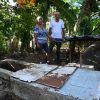Tuesday, April 30, 2024
News and Views from the Global South
ENVIRONMENT-SOUTH AMERICA: Controversy Rages Over Pulp Mill Plants
Gustavo González*
- The cellulose industry is expanding in South America as governments in the region seek foreign investment. But environmentalists complain of the ecological and social impacts of the pulp mills, which are among the most profitable of the forestry sector activities.
In Chile the causes of a late 2004 die-off of black-necked swans in the Río Cruces nature reserve in the southern province of Valdivia have not yet been officially clarified.
Nevertheless, the authorities reached a heavily criticised decision to allow the pulp mill accused of causing the disaster with its liquid waste effluent to reopen after it was shut down for just one month.
Chile exports two million tons of wood pulp a year, which accounts for 2.2 percent of global output, far below the United States, the world leader, which produces 30.5 percent of the total, Roberto Ipinza, director of the Ministry of Agriculture’s Forestry Institute, told IPS.
But cellulose is surpassed only by copper in generating foreign exchange for Chile.
Brazil is the world’s seventh largest producer, accounting for three percent of global supplies, thanks to exports that have tripled in the past ten years.
Brazil’s paper and pulp industry had a turnover of 8.5 billion dollars in 2004 and involves 220 companies that directly employ 100,000 workers.
Most of the world’s paper is made from wood pulp. The species of trees most commonly used to produce pulp, or cellulose, in Latin America are fast-growing eucalyptus and pine, which are often planted in areas that once held native forests.
Eucalyptus and pine plantations in Argentina, Brazil, Chile and Uruguay represent 40 percent of the 10 million hectares of rapid-growth tree plantations worldwide.
Fast-wood plantations now cover more than 600,000 hectares in Uruguay, or four percent of the country’s productive land. The native temperate forests cover 810,000 hectares.
Uruguay’s forestry exports totalled 86.5 million dollars in 2002, with 43 million dollars representing raw wood, according to the national Forestry Directorate. The country’s overall foreign sales that year reached 2.2 billion dollars.
There is a strong movement in Uruguay opposed to the planned installation of two pulp mills in the western department (province) of Río Negro, on the Uruguay river along the border with Argentina.
The plants are to be built by the Finnish firm Botnia, at a cost of 1.1 billion dollars, and a Spanish company, Ence, which plans to invest 500 million dollars.
A group of personalities, including Argentine human rights activists Adolfo Pérez Esquivel (a Nobel Peace laureate) and Hebe de Bonafini, and the internationally renowned Uruguayan writer Eduardo Galeano wrote an open letter against the pulp mill projects, at the World Social Forum in Porto Alegre, Brazil on Jan. 31.
The letter was addressed to then president-elect Tabaré Vázquez, the leader of Uruguay’s now-governing leftist Broad Front.
According to the signatories of the letter, the pulp plants will not only be a source of pollution, but will also lead to the elimination of local jobs in agriculture, tourism and fishing, while having an impact on the health of the local population in both Uruguay and Argentina.
Nevertheless, during the Vázquez administration’s first week in office last March, Economy Minister Danilo Astori said in an interview with IPS that Botnia’s confirmation that it planned to go ahead with the investment was "the best news we have had in the last few days," because Uruguay "needs investment to generate wealth and quality jobs."
In the past two decades, there have also been conflicts over the enormous eucalyptus plantations in Brazil, mainly in the east-central state of Espíritu Santo and the northeastern state of Bahía, where environmentalists complain that native forests have been cut down to make way for woodpulp trees, and that the industry uses excessive mechanisation and technologies that reduce employment possibilities.
But Luiz Ernesto Barrichelo at the University of Sao Paulo Institute of Forestry Research (IPEF) told IPS that in general the pulpwood plantations were planted in areas that were already deforested, abandoned or in use as pastureland.
The expert also said there are "myths" about the environmental damages caused by eucalyptus trees. He noted that a high level of water consumption is normal with any fast-growing tree species, whether native or exotic, and said it is "absurd" to argue that eucalyptus trees leave soil infertile or that the leaves block the growth of other species.
Ipinza in Chile also said the pine and eucalyptus pulpwood trees have been planted on eroded soil that had already been abandoned by agricultural producers and stockbreeders.
Biologist Adriana Hoffman, who heads Defenders of the Chilean Forest, disagreed, however. Speaking with IPS, she said pine and eucalyptus trees "have often been planted to replace the native forests" – an alarming development for those who are fighting to defend the country’s natural resources.
Hoffman, who headed the governmental National Environment Commission (CONAMA) from March 2000 to November 2001, at the start of the current administration of President Ricardo Lagos, stressed that the worst environmental impacts are caused by pulp mills, as shown by the "horror of Río Cruces".
But in Ipinza’s view, "the environmentalists are stuck in the past, because today the processes for extracting cellulose from wood are much cleaner and cause very little pollution."
The plants operating in Chile are mainly "third-generation, which use elements that pollute very little," he added.
Hoffman acknowledged that "It is possible to install a relatively clean cellulose plant, but greater investment is needed" to properly treat the liquid waste, to avoid generating large quantities of toxic substances.
Activists complain that Chile’s environmental authorities have failed in their oversight responsibilities with respect to reducing pollution by pulp mills, as shown by the disaster in the Río Cruces nature sanctuary, which was home to the largest population of black-necked swans (Cygnus melancoryphus) in South America.
Of the 6,000 swans that nested in the reserve located 790 kms south of Santiago, only 290 are left. Hundreds died and around 4,000 migrated when their main food supply, a waterweed known locally as luchecillo, disappeared, apparently destroyed by the liquid waste dumped by the Valdivia cellulose plant 15 kms upstream.
The factory belongs to the Celulosa Arauco y Constitución (Celco) company, that is the property of Anacleto Angelini, the head of the second largest business group in Chile, which has forestry investments in Uruguay and Argentina as well.
In Argentina, for example, the Angelini Group owns a bleached wood pulp plant on the Alto Paraná river.
The death of the swans was investigated by experts from the Ramsar Convention (a global treaty that has protected the world’s wetlands since 1971), who visited Chile in late March and are due to release their report shortly.
A final report should also come out this month from the Austral University of Valdivia. The delay in producing the report has awakened suspicions among environmentalists, and has even annoyed CONAMA Director Paulina Saball.
Nevertheless, it was CONAMA itself that granted Celco a three-year grace period for installing a discharge pipe at another pulp mill, in Itata valley, 400 kms south of Santiago. The installation of the new plant in Itata, a traditional wine-growing region, has run up against strong resistance from environmentalists and local agricultural producers.
Although the swans have become the high-profile symbol of the Río Cruces disaster, Hoffman also pointed to the damages that the Valdivia plant has caused other species, as well as local residents.
"We have reports that the polluted water and gas and liquid emissions have affected people’s health, with a rise in health problems including gastric and bronchial ailments," she said.
"And a doctor who was carrying out a campaign to raise awareness not only about the swans but also about the health risks posed by the pulp mill died late last year when his lung cancer took a turn for the worse because of the plant’s emissions," said Hoffman.
A somewhat similar case occurred in Minas Gerais, in southern Brazil, where a small pulp mill dumped its waste into a river, killing off fish. But according to Melquiades Spinola at the Centre of Studies and Research for the Development of the Extreme South, the worst impacts of the pulp industry are economic and social.
The main damage caused by the four paper and pulp factories operating in the southern part of the state of Bahía is unemployment, while "there are 12,000 families of (landless) peasants living in camps along the roadsides," Spinola remarked to IPS.
Barrichelo said Veracel, a Brazilian-Swedish-Finnish company installed in 1992, promised to generate 10,000 direct and indirect jobs, but has only hired 300 workers at the plant and another 1,000 on the tree plantations.
In Uruguay, the non-governmental Grupo Guayubira, which is fighting the installation of the pulp mills in Río Negro, has drawn public attention to the case of the swans in Río Cruces in Chile.
On Feb. 22, President Vázquez met with Botnia executives to give them the final go-ahead for the installation of their plant. But Guayubira filed an injunction with the Ministry of Housing, Territorial Ordering and the Environment requesting that it revoke the permit that the administration of Jorge Batlle (1999-2005) granted the Finnish company.
"Commitments assumed by the previous government will undoubtedly somewhat tie the hands of the new government. But we are confident that the (Vázquez) administration can make the strength of the people’s determination its own, to face up to these pressures," a Guayubira activist told IPS.
* With additional reporting by Diana Cariboni in Uruguay and Mario Osava in Brazil.

 Print
Print



